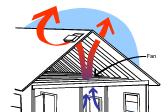
Mechanical ventilation (or forced ventilation) takes advantage of fans to help draw air in a particular direction to control ventilation in your home.
Mechanical or powered ventilators are a step up from natural ventilation (like wind-driven ventilation) in that they create a more powerful and controllable cooling effect, but they also carry the price tag that reflects this difference. Powered ventilators are particularly important in passive style houses that are sealed tightly, where natural ventilation isn’t a viable option. Because of the control they allow, they’re also a lot more reliable in providing fresh air (without pollutants) and help to prevent unwanted temperature fluctuations.

Types of mechanical ventilators
There are three main types of powered ventilators – exhaust fans, heat recovery ventilators (HRVs) and energy recovery ventilators (ERV). These systems forcibly remove warm, stale or humid air from your home and replace it with fresh air, usually a lot faster than natural alternatives. Heat recovery ventilators and energy recovery ventilators also help to regulate the indoor temperature.
Exhaust fans
Exhaust fans are most often found in bathrooms and kitchens, and are designed to forcibly remove steam and odour from these areas. They work by sucking air out from a localised area through a vent, then transporting it outdoors through a duct.
Heat recovery ventilators (HRVs)
Heat recovery ventilators are complicated devices that help to ventilate a room with fresh air while maintaining warmth. HRVs use heat exchange technology to capture the warmth and use it to actively heat the incoming fresh air.
Energy recovery ventilators (ERVs)
Less common and more expensive than HRVs, ERVs can best be described as the ventilation equivalent of reverse cycle air conditioners, in that they can be effective for both cooling and heating a space. While very similar to HRVs, ERVs also capture any moisture in older air and uses it to cool warmer air in summer months. HRVs are considered to be a specific, single purpose type of ERV.
The added cost
Powered ventilators, while more effective than natural ventilators, cost you more to buy, install, operate and maintain. They can cost even more if you get a ventilator that features moisture transfer or defrost control, and more again if you opt for a three-speed model over a single speed one.
|
Advantages
|
Disadvantages
|





